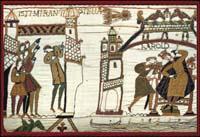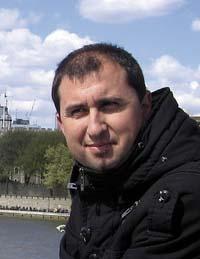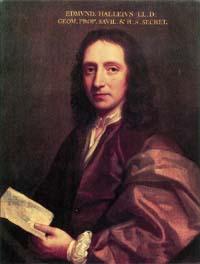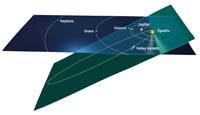Comet Halley in history

"An event of these characteristics caused panic and amazement. The historian of the UPV-EHU, Alvaro Aragón, states that "normally it was associated with a natural catastrophe or an epidemic".
1066. Conquest of England
It could also be the opposite. "In 1066, the comet that appeared when the Nordic king Conquistador de Gil was going to conquer England," says Aragon. Gilen accepted the apparition as a sign of good luck. "Some said it was a call."
The comet was represented in the Bayeux tapestry, in a giant tapestry of 70 meters in length that was made in remembrance after the conquest. As if it were a comic, in the tapestry were embroidered scenes of the conquest, where the comet Halley appears in the part before the Normans crossed the channel of the Mancha.
For Norman the appearance of Halley was a good sign, but for the Anglo-Saxons who wanted to defend England it was a sign of disaster. "It has always had these two approaches and we have to keep in mind that religion and myth had a huge influence and that science was not very developed. It was customary to have a magician in court next to the king. We would tell them magician, but for them he was an astronomer, he measured the movements of the stars, he defined the calendars, etc. They often organized battles or wars based on that; if the stars were favorable, they advanced."
1145. Monk
The next appearance is also recorded and in England was cited by the monk Eadwine. However, it is not a very reliable record. "The testimonies are not very clear, that is the problem," says Aragón. And this was of great importance when later Edmund Halley wanted to confirm that the comets of various representations were a single comet. To be sure, I had to collect records of appearances and it is not stated that Halley knew Eadwin's record.

In addition, in the absence of registration, another problem must be added when investigating comet Halley, with apparitions every 76 years approximately, but this number is not accurate and changes from one orbit to another of the comet. For example, since he saw the Conquistadora de Gil until he saw the Eadwine monks, 79 years passed, a few more years than the previous one.
"Halley's period is 74-79 years," says Aranzadi Science Society astronomer Kristina Zuza. "It is a small mass star and the attraction force it receives when passing near a planet, especially near Jupiter or Saturn, easily alters Halley's trajectory. This effect sometimes accelerates and sometimes slows down and thus changes the comet period."
1222. Recent searches
XIII. The appearance of the 20th century has been associated with the Mongolian emperor Gengis Khan. "The appearance coincides with the time when Gengis Khan slaughtered. And then his nephew Kublai Khan conquered China," says Aragon. There is no document that says that the two conquerors saw the comet, but those who saw it considered it an announcement of the conquests.
1301. Giotto
It was 79 years until comet Halley reappeared in 1301. And the painter Giotto may have seen it. There is no certainty of this, but in the painting Cult of the Magi that he painted three years later a star appears in the form of a comet.
"It is often heard that Halley may be the star of Christmas births. But that is not proven; once the estimates are made, the date does not coincide," says Aragón. This painting by Giotto can make the image of the star of Bethlehem comet.
However, the Cult of the Magi is not the first picture depicting the birth with a comet star. Years before, in the birth picture of Jesus by Pietro Cavallini also appears the star of Bethlehem. This table is 1292, prior to the appearance of 1301. There is therefore doubt about Giotto: Did he represent Comet Halley or did he shape the star of Bethlehem by Cavallini's picture? Experts do not agree either.
In any case, the painting The Cult of the Magi by Giotto has become an icon over time and has been linked to the name of Comet Halley. In fact, in 1986, when the comet last passed near Earth, the probe was sent to closely analyze the comet that the space agency ESA called Giotto.

1378. No registration
In 1378 comet Halley would again be visible from Earth, but there is no historical record of that apparition. The next appearance is 1456.
1456. Constantinopolis
Those who saw it related it to the conquest of the city of Constantinopolis. Three years before the comet arrived, the Ottomans took the city. Today we call it Istanbul, capital of the eastern Roman Empire.
"Some believe that the appearance of the comet was God's prediction. Christianity did wrong things and the conquest of the Ottomans was considered a punishment. And the visit of the comet that was the approval of the heaven of that penalty", says Aragon.
The conquest of Constantinopolis has been considered as the end of the Middle Ages, for example in classical education. From 1453, Europe entered another era, the Renaissance. It is a traditional, though not unique, historical classification. However, from the point of view of the science of comets, it is true that at that time the first ideas arose to face the myth.
One of those who discovered the comet in 1456 was astronomer and mathematician Johann Müller. "He translated some works by Ptolemy," says astronomer Cristina Zuza. "That's why I was so dressed in astronomy. And he was the first to consider the trajectory of a comet. In his opinion, the comet made a correct tour. I was wrong, but it was the first scientific contribution in a comet."
1531. Time of reform

XVI. The emergence of the 20th century represented great advances in comet research. This appearance is in the register of the German humanist Petrus Apianus, who made the first scientific illustration of a comet to illustrate it. Years later, the Italian Jerónimo Fracastoro concluded that the comets have no tail towards the Sun, but towards the other side.
For the astronomer torch is a breakthrough. "To reach that conclusion you have to take into account where the Sun is, but not only with the Earth, but also with the comet. And at what point is the comet and whether it has a round trip. It is not easy to realize this in a society where geocentrism was an example."
Tycho Brah did not see Halley, but made another breakthrough in comet research. He discovered that they are out of the atmosphere. To conclude this, he tried to measure the parallax of another comet, comparing the movement of the comet with the image of distant stars.
The stars are considered to be standing (moving very slowly) and the comet, seen from two points, changes the visible position compared to that rear bottom. This change allows calculating the distance to commas. But Brah did not see the parallax of the comet and concluded that it was not near, the comet should be out of the atmosphere and at least four times farther than the Moon. With this idea he completely renewed his knowledge of comets.
The change of thought was important, but man was willing to accept such changes; the years of 1531 were times of change in history.
"By then they already knew America," says Aragon. "And by then the printing press was already underway and these two things had a great influence on science."
In addition, one of the biggest religious reforms in Europe was happening. Martin Luther's revolution was underway and, in 1531, in Switzerland, a sect separated from Protestantism, the Zwinglitos, suffered a terrible failure in the battle of Kappele. The following were the Calvinists. A reformed church is created.
Thought was being renewed. "Halley's appearance was regarded by some as a sign contrary to this new thought and by others as a favorable sign. Catholics used the appearance in their favor, saying that their religion was real and that God did not accept reforms."
1607. Kepler

Tycho Brahe died in 1601, six years before the appearance of Halley, but two collaborators of Brahe saw comet Halley in 1607: Longomontano and Johannes Kepler.
Kepler is a great name in astronomy, especially because he deduced that the orbits of the planets are elliptical. But paradoxically I didn't think comets were moving in elliptical orbit. Nor did I think they moved in orbit. For him, as for Müller, they had a direct tour. "Surely Kepler saw the comets in a very different way, and it is that he had very little chance of comparing the trajectory of the comets with the model of the orbits of the planets," says Zuza.
In those years Galileo had begun to look from the telescope. And soon other astronomers started using it. In 1618, the Swiss Johann Cysat first observed a comet with a telescope. However, he confirmed the theory of direct route.
In 1665, the Italian Giovanni Alfonso Borelli affirmed that the trajectory of the comets could not be correct; he proposed that it should be a parable.
With such ideas, the idea of the solar system was gradually being formed. They were small advances but, in that context, very strong. "The theory of heliocentrism was still very young and, although it is already known, it was little widespread and had little importance," says Zuza.
Of course, the mythical image of comets was still strong. This is the case of Spanish history. Spain was the empire of that time, but by then it had already begun to decay a little. In 1598 he signed the peace of Vervins with France, in 1604 with England and in 1609 with the United Provinces of Holland. And that same year Philip III announced the expulsion of the Moors. "According to some chronicles, the appearance of Halley was considered an announcement; a message from God to carry out that action," explains Aragon.
1682. Newton and Halley
This appearance had the most important witness in history: Edmund Halley. Friend of Isaac Newton, he knew the new theory of gravity. Two great scientists work somehow together.

But for Aragon it is no coincidence that these two great names are at the same time and the same places: "The main revolution of science took place in the Enlightenment, but in England it began years earlier. They were in a special historical and political context, by then they had a parliamentary monarchy, they killed the king and had two revolutions (the revolution for one republic and another to regain the monarchy). The existence of this political environment provoked a scientific environment and a more open thought compared to other countries. That's why people like Newton and Halley emerged."
Halley began to apply Newton's new theory to comets and realized that the comets seen in 1531 and 1609 and what he saw in 1682 could be the same comet if it had an orbit of a certain period.
"In addition, comet Halley has other characteristics," says Zuza. "It has a rotation opposite the planets, with backward movement; the orbit completes the reverse direction. And on the other hand, its orbit presents an inclination of 18 degrees to the ecliptic, which means that, seen from Earth, it appears in the same constellations of the sky. And it seems that Halley also took these two things into account."
From these ideas he dared to make an announcement that the comet would return in 1758. Halley himself died in 1742. And in 1758 the comet did not appear.
1759. Comet Halley
It is not entirely accurate to say that in 1758 it did not appear. Because amateur astronomer Johann Georg Palitz detected it on December 25. But the comet passed through the perihelion (nearest to the Sun) on March 13, 1759, when most of the observations were made. The first professional observation was made by the French astronomer Charles Messier on 21 January. However, Halley's prediction was fulfilled and the comet was named.






